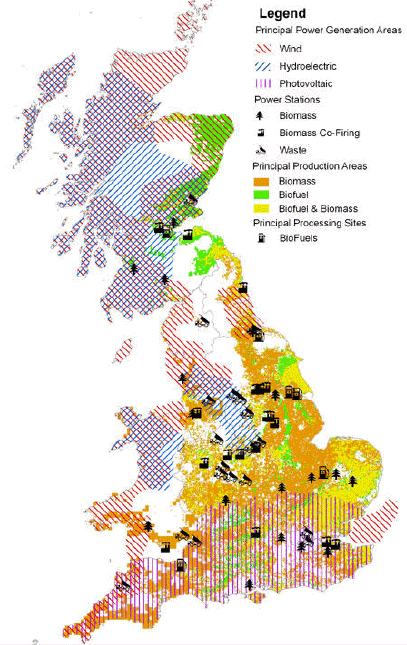London, United Kingdom
July 14, 2006
USDA/FAS GAIN Report Number: UK6025
Source:
http://www.fas.usda.gov/gainfiles/200607/146208312.pdf
Report Highlights:
The UK government has set
targets to achieve 20 percent of electricity generation from
renewable energy sources by 2020, and to have 5 percent of
the country’s needs for automobile fuel met with biofuels by
2010. To meet these targets, it is estimated that 7 percent
of the UK’s land will be dedicated to energy crops such as
willow, and that an increase of about 1 million hectares of
oilseed rape will be required.
 |
A Vision of the
Distribution of Renewable Energy Sources
in the Great Britain of 2020
Source: ADAS |
Renewable energy is an integral
part of the UK government’s long-term aim of reducing carbon
dioxide emissions by 60 percent by 2050. The UK utilizes the
power of the sun, wind, waves, tides, and biomass (including
waste) to generate electricity. Today renewable energy sources
account for just 5 percent of the UK’s total electricity output,
but the UK government has set a target to increase this to 20
percent by 2020.
Within the renewable energy
sector, biomass currently makes up 32 percent of UK renewable
electricity generation. It is estimated that to meet future
needs energy crops, such as willow, would have to cover an area
of 15,200 square km (7 percent) of Britain’s land area.
In addition, there are also likely
to be significant land use changes to meet the UK government’s
Road Transport Fuels Obligation. This includes a target of 5
percent inclusion of biofuel within all fuel by 2010. The demand
for bioethanol to blend with petrol is likely to be met with
surpluses of domestically produced wheat and sugar beets.
However, to achieve sufficient oil for the production of
biodiesel, the UK will need to significantly increase the area
of oilseed rape by around 0.7 million to 1 million hectares.
Currently there are 1.8 million hectares used for cereals in
Great Britain.
While the benefits to the
environment in terms of greenhouse gas savings could be
substantial, the UK’s renewables revolution will need to be well
planned to avoid serious consequences for biodiversity and water
tables. A study by the environmental consultants ADAS predicts
that much of the biomass and biofuel crop increase will be seen
in the East Midland region of England. As much as 20 percent of
land in this region may be planted to willow and miscanthus.
Sustainable land management will be a key factor since
cultivation of single crops could result in lowered water tables
and/or a loss of habitat for declining wildlife species.
A balance of land use will need to
be achieved between the renewables industry and food production.
The UK agribusiness consultancy – ADAS predicts that “UK farmers
will begin to diversify from traditional practices to include
alternative energy generation, so that UK agricultural
businesses will be enjoying improved economic performance by
2030”.
Source:
http://www.fas.usda.gov/gainfiles/200607/146208312.pdf |